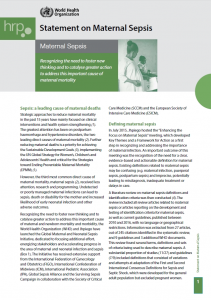
Sepsis: a leading cause of maternal deaths
Strategic approaches to reduce maternal mortality in the past 15 years have mainly focused on clinical interventions and health system strengthening. The greatest attention has been on postpartum haemorrhage and hypertensive disorders, the two leading direct causes of maternal mortality. Further reducing maternal deaths is a priority for achieving the Sustainable Development Goals, implementing the UN Global Strategy for Women’s, Children’s and Adolescents’ Health and critical for the Strategies toward Ending Preventable Maternal Mortality (EPMM).
However, the third most common direct cause of maternal mortality, maternal sepsis, received less attention, research and programming. Undetected or poorly managed maternal infections can lead to sepsis, death or disability for the mother and increased likelihood of early neonatal infection and other adverse outcomes.
Recognizing the need to foster new thinking and to catalyse greater action to address this important cause of maternal and newborn mortality and morbidity, the World Health Organization (WHO) and Jhpiego have launched the Global Maternal and Neonatal Sepsis Initiative, dedicated to focusing additional effort, energizing stakeholders and accelerating progress in the area of maternal and neonatal infection and sepsis (Box 1). The Initiative has received extensive support from the International Federation of Gynecology and Obstetrics (FIGO), International Confederation of Midwives (ICM), International Pediatric Association (IPA), Global Sepsis Alliance and the Surviving Sepsis Campaign in collaboration with the Society of Critical Care Medicine (SCCM) and the European Society of Intensive Care Medicine (ESICM).